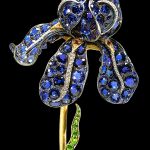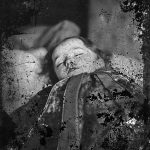
The Victorian era was rife with unique and often unsettling artistic expressions, with hair art standing out as one of the most intimate and macabre forms. Hair art, which involved creating intricate designs, jewelry, and decor from human hair, was particularly popular as a form of memento mori—objects intended to remind the living of their mortality. This unusual art form served not only as a way to commemorate loved ones who had passed but also allowed Victorians to keep a part of them physically close. As morbid as it may seem today, hair art was cherished and deeply personal, combining artistry with poignant sentimentality in ways that still fascinate historians, collectors, and art enthusiasts alike.
Origins of Victorian Hair Art: A Cultural Response to Loss
Victorian hair art can be traced back to the broader mourning culture that permeated society during Queen Victoria’s reign. After the death of her husband, Prince Albert, in 1861, Queen Victoria entered a deep period of mourning, dressing in black and withdrawing from public life. Her influence set the tone for a culture that increasingly found comfort in physical mementos of loved ones who had passed. Hair, believed to contain a piece of a person’s essence, became an ideal medium for these keepsakes, immortalizing the memory of the departed. Families would commission intricate hair art pieces from professional artisans or even create pieces themselves, passing down the skills from generation to generation.
Techniques and Styles in Victorian Hair Art
Victorian artisans developed several techniques for working with hair, each demanding patience and meticulous detail. Hair was woven, braided, or even knotted into intricate shapes and patterns. Artists would often incorporate hair into designs that resembled natural elements such as flowers, leaves, or trees—symbols often associated with life cycles and rebirth. Some artists created “palette work,” where hair was flattened and shaped onto a surface, resembling miniature paintings. Others worked in a style called “table work,” which involved using tiny hair strands to form sculptural pieces, ranging from jewelry like brooches and lockets to more extensive, framed hair wreaths that adorned walls in Victorian homes.
The Role of Mourning Jewelry in Victorian Society
Mourning jewelry was central to Victorian hair art, worn as a sign of respect and memory. Brooches, lockets, rings, and pendants became popular as subtle yet visible symbols of loss and remembrance. Many of these pieces featured compartments that held the hair of the deceased, sometimes hidden behind a glass panel. These accessories were often paired with other motifs, such as flowers, doves, and weeping willows, all symbolizing peace and eternity. Wealthier Victorians could afford elaborate pieces, often incorporating gold, silver, or enamel into their mourning jewelry, while those with fewer resources crafted simpler yet equally heartfelt mementos.
Hair Wreaths: Decorative Yet Solemn Mementos
Hair wreaths were another form of hair art, combining artistry and sentimentality in a visually stunning display. Typically displayed in shadow boxes, hair wreaths featured loops, spirals, and floral shapes made from various family members’ hair, often intended as tributes to an entire family or group. The hair in these wreaths was painstakingly cleaned, dyed, and arranged, preserving its structure for display. Wreaths typically followed a circular pattern, symbolizing the eternal cycle of life and death. Some even had central points, such as a photograph or an initial, to honor a specific family member. These wreaths were cherished as family heirlooms and often passed down through generations.
The Significance of Memento Mori in Victorian Culture
Memento mori, a Latin phrase meaning “remember you must die,” was more than an aesthetic choice; it was a philosophy that shaped many aspects of Victorian life. The Victorians lived in a time when death was a familiar, often close presence due to high mortality rates, particularly among children. Embracing memento mori allowed individuals to confront death more openly. Hair art provided a means to preserve memories in a tangible, intimate form, transforming grief into creative expression. By wearing or displaying these pieces, Victorians found solace in the idea that their loved ones’ memory lived on within these cherished objects.
Symbolism Embedded in Hair Art Designs
Symbolism was essential in Victorian hair art, adding layers of meaning to each piece. Different shapes and colors often held specific significance: for instance, white flowers were used in hair art pieces for children or young women who died unmarried, symbolizing purity and innocence. Darker hues and tree motifs might represent endurance or mourning. Floral designs were prevalent, as Victorians associated flowers with the cycle of life and the transient nature of beauty. Roses symbolized love and loss, while ivy, often used in hair wreaths, represented fidelity and eternal remembrance. These symbols allowed the art to speak a language of its own, resonating deeply with those left behind.
Preservation of Victorian Hair Art in Modern Times
Today, original Victorian hair art is rare but highly valued among collectors and museums dedicated to mourning art. The delicate nature of hair means that these pieces require careful preservation, and the aging process can make them fragile. Hair art collections in institutions like the Leila’s Hair Museum in Missouri preserve these historical artifacts, offering insights into the Victorian fascination with death and memory. Collectors seek out authentic pieces for their historical significance, craftsmanship, and the insight they provide into Victorian values surrounding life, love, and loss. These collections allow modern audiences to explore a bygone era’s intimate approach to mourning.
Victorian Hair Art as an Expression of Love and Remembrance
While the practice of hair art might seem morbid today, for Victorians, it was an expression of love and respect. Creating art from hair required both skill and patience, adding an intimate touch to each piece. These works served as reminders of loved ones who had passed on and allowed the bereaved to keep a physical part of them close. For some, hair art offered a way to process grief creatively, providing a unique blend of personal expression and memorialization. The process itself could be cathartic, transforming sorrow into something meaningful and lasting.
Rediscovering Victorian Hair Art in Popular Culture
In recent years, Victorian hair art has experienced a resurgence in popular culture, attracting the attention of modern artists and enthusiasts alike. Inspired by the intricate craftsmanship and rich symbolism, some contemporary jewelry makers have revived hair art, using synthetic materials to mimic the effect or incorporating human hair for a more authentic touch. Gothic and vintage aesthetics have also embraced Victorian mourning customs, showcasing hair art as a fusion of historical tradition and modern design. This renewed interest speaks to a broader cultural fascination with mortality, memory, and the enduring appeal of the macabre.
Why Victorian Hair Art Still Captivates Us Today
The allure of Victorian hair art lies in its blend of beauty, sentiment, and mortality. It speaks to universal themes—love, loss, and remembrance—that remain relevant across generations. As society continues to evolve, so too does our understanding of mourning and memorialization. Victorian hair art offers a window into how previous generations coped with grief and memory, allowing us to reflect on our approaches to these timeless human experiences. The pieces that survive are not only works of art but also poignant reminders of a time when confronting mortality was integral to daily life.
Conclusion
Victorian hair art is a captivating blend of artistry, sentiment, and historical tradition. While it may seem strange today, this practice served an essential role in Victorian mourning culture, offering both comfort and a means of preserving memories. Through intricate designs and thoughtful symbolism, hair art transformed personal loss into beautiful, enduring keepsakes. As we look back on these pieces, we find a unique art form that still resonates with themes of love, loss, and the inevitability of death. In remembering the past, we gain insights into our shared human experience and our ever-evolving relationship with mortality.
Key Takeaways
- Victorian hair art emerged as a form of memento mori, preserving memories through intricate designs made from human hair.
- Techniques included braiding, weaving, and palette work, often symbolizing life, death, and eternal remembrance.
- Mourning jewelry allowed individuals to keep physical parts of loved ones close, reflecting Victorian values around loss.
- Hair wreaths honored entire families, with circular designs symbolizing life cycles.
- Modern interest in Victorian hair art reflects a renewed cultural fascination with death and memory.
FAQs
- What was the purpose of Victorian hair art?
Victorian hair art was often created as a form of memento mori, helping people remember and honor their deceased loved ones. - Why did Victorians use hair in art?
Hair was considered a personal, lasting keepsake, symbolizing the essence of the departed and allowing people to keep them close. - Are Victorian hair art pieces valuable today?
Yes, original Victorian hair art pieces are rare and highly sought after by collectors for their historical and sentimental significance. - Did all Victorian families create hair art?
While popular, hair art was more accessible to wealthier families, though simpler forms were created by those with fewer resources. - What symbols were common in Victorian hair art?
Common symbols included flowers, trees, and weeping willows, each representing themes like love, loss, and eternity.




